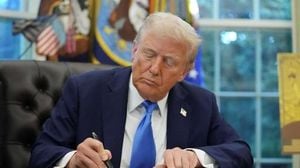On a bleak February day in 2024, news broke that Alexei Navalny, Russia’s most prominent opposition leader, had died in a remote Arctic penal colony. The official story, as reported by the Federal Penitentiary Service, was that Navalny “felt unwell after a walk, almost immediately lost consciousness, and could not be revived despite resuscitation attempts.” For many, especially his supporters and family, this explanation never sat right. Now, more than a year later, the controversy has reignited with startling new claims from Navalny’s widow, Yulia Navalnaya, who says independent laboratories have confirmed her husband was poisoned in prison.
On September 17, 2025, Yulia Navalnaya took to social media to share a video message that quickly drew international attention. In it, she stated, “We managed to transfer Alexei’s biological materials abroad. Laboratories in two different countries conducted examinations. These laboratories, independently of each other, concluded that Alexei was poisoned. These results are of public importance and must be published. We all deserve to know the truth.” According to ABC News and other outlets, Navalnaya’s claim is based on biological samples that were secretly smuggled out of Russia prior to her husband’s burial. The laboratories, whose names she did not disclose, allegedly analyzed these samples and reached the same conclusion: Navalny was killed by poisoning.
This revelation adds a new layer to a saga already marked by suspicion, secrecy, and tragedy. Navalny, 47 at the time of his death, was serving a sentence of nearly two decades on charges widely viewed as politically motivated. He had been transferred to the “Polar Wolf” penal colony, a maximum-security facility about 40 miles north of the Arctic Circle, just months before his death. Supporters, including Yulia Navalnaya, have long argued that this move was part of a deliberate plan to isolate and ultimately silence him. She alleged in her statement that Arkady Gostev, head of the Federal Penitentiary Service, inspected the remote facility twice in the year before Navalny’s transfer, suggesting that authorities may have had ulterior motives for sending him there. “Why was this remote, closed, and harsh [prison] colony so attractive? Perhaps because nothing and no one there could prevent them from finishing the job. And they did finish it,” Navalnaya said in a video posted to YouTube, as reported by RFE/RL.
Navalny’s final days, as reconstructed by his allies and family, were harrowing. On February 3, 2024, he complained of leg pain and was briefly examined in the prison’s medical office—an office he later described as “staged” and lacking real doctors. On February 14, he was moved from cell 19 to cell 16, a solitary confinement punishment cell. Two days later, during a morning walk, he told guards he felt unwell. According to incident reports cited by Navalnaya, he crouched down, complained of chest and stomach pain, and began to vomit. Instead of being taken to the infirmary, he was returned to his cell, where his condition rapidly deteriorated. “Aleksei lay down on the floor, pulled his legs up to his stomach and started groaning from pain,” Navalnaya recounted in her video, referencing written testimonies from five prison staff members. “He said that his chest and stomach were burning. Then he began to vomit.”
Photographs released by Navalny’s allies show a cramped prison cell with what appears to be vomit and blood on the floor, alongside a notebook and an Oxford dictionary. Leonid Volkov, one of Navalny’s closest allies, wrote on X that Navalny had been “murdered in an agonising way, with poison.” Despite the severity of his symptoms, medical care was delayed. A prison ambulance was not called until over 40 minutes after his first complaints, and by the time he was finally taken to the medical office, he had lost consciousness. Medical workers who arrived in an ambulance soon after pronounced him dead, listing “sudden death syndrome” as the preliminary cause, according to incident reports cited by The New York Times.
The Russian government has consistently denied any wrongdoing, insisting that Navalny died of natural causes—a mixture of diseases, including heart arrhythmia triggered by hypertension. Kremlin spokesperson Dmitry Peskov said he was unaware of Navalnaya’s latest claims and declined to comment further. The official narrative has been buttressed by altered medical records, according to reporting by The Insider, which found that symptoms suggestive of poisoning were omitted from later versions of Navalny’s death report.
Western governments and international rights organizations have repeatedly condemned the Russian authorities for Navalny’s imprisonment and treatment, holding the Kremlin responsible at least indirectly for his death. Navalny’s earlier near-fatal poisoning in 2020 with a military-grade nerve agent, which he and his supporters blamed on President Vladimir Putin and the Federal Security Service, only heightened suspicions. After recovering in Germany, Navalny returned to Russia in January 2021, where he was immediately arrested and sentenced to a series of lengthy prison terms. His death in 2024 was met with widespread outrage and sorrow among his supporters, who saw him as a symbol of resistance against corruption and authoritarianism.
Yet, not all share Navalnaya’s certainty regarding the manner of her husband’s death. According to The Wall Street Journal and the Associated Press, U.S. intelligence agencies have assessed that it is unlikely President Putin directly ordered Navalny’s killing, a view that stands in contrast to the accusations leveled by Navalny’s family and allies. This divergence reflects the broader uncertainty and opacity that have surrounded the case from the beginning.
Adding to the intrigue, Navalnaya revealed that surveillance footage from the final day of Navalny’s life had vanished, despite the fact that he was under near-constant camera monitoring throughout his imprisonment. This disappearance, combined with the week-long delay in releasing Navalny’s body to his mother, has fueled suspicions of foul play and a cover-up among his supporters.
Navalnaya has called for the laboratories that analyzed her husband’s biological samples to release their findings publicly, arguing that “everyone would know the truth.” She accused Russian President Vladimir Putin and the country’s security services of orchestrating the murder, though she acknowledged that she could not provide direct evidence. “I accuse the Russian security services of developing prohibited chemical and biological weapons. I demand that the laboratories which conducted the studies publish their results. Stop playing games with Putin out of some higher considerations,” she declared.
The Kremlin’s history of using poison against political opponents is well documented, from the radioactive polonium that killed Alexander Litvinenko in London in 2006 to the nerve agent attack on former spy Sergei Skripal in Salisbury in 2018. Navalny himself was the target of a notorious poisoning attempt in 2020, barely surviving after being treated in Germany. These precedents have only strengthened the resolve of those who believe that the Russian state bears ultimate responsibility for his death.
In the wake of these new allegations, the world is left with more questions than answers. The fate of the laboratory reports remains uncertain, and the full truth behind Alexei Navalny’s death may never be known. But for Yulia Navalnaya and her husband’s supporters, the pursuit of justice—and the demand for transparency—shows no sign of fading.





